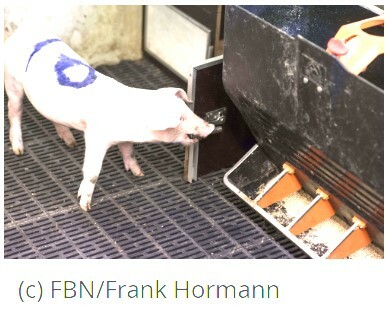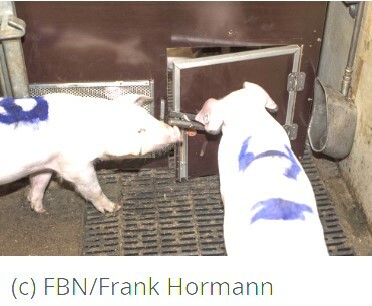



New research investigates helping behavior in pigs
Spontaneous helping in pigs is mediated by helper's social attention and distress signals of individuals in needPigs are known for their intelligence and social nature. Can they recognize when a fellow pig needs help and actively support each other? A pioneering project at the Research Institute for Farm Animal Biology (FBN) in Dummerstorf aims to answer these questions by using a novel design to study spontaneous helping behavior in pigs within their social groups.
The project, entitled "Let me out! Proximate factors mediating helping behavior in pigs", focuses on testing whether pigs help each other out of concern for others or for selfish reasons. It is being conducted in close collaboration with researchers at the University of Veterinary Medicine, Vienna, and is funded by grants from the German Research Foundation (DFG) at the FBN, and the Austrian Science Fund (FWF), at the Vetmeduni, Vienna. The total funding amounts to 736,089 euros for three years.

Dr. Liza R. Moscovice (FBN) and her collaborator Prof. Jean-Loup Rault (University of Veterinary Medicine) have developed a novel way to study helping behavior where pigs can be tested in their normal social groups within their usual barn environment. Two identical compartments are attached to the pigs’ pen. Each compartment has a window and a door, which can only be opened from the outside, by lifting a handle high enough to release a latch.
One pig is taken out of the pen briefly, and then placed into one of the two compartments. The other pigs can then decide freely, without any training if they want to open a door, and if so, whether to open the door to reunite the trapped pig with its group or whether to open the door to the empty compartment.
"In the first part of the project, we are evaluating the influence of relatedness, dominance relationships and personal experience of being trapped on decisions about helping," explains Dr. Liza R. Moscovice. "This will help us to understand how these factors influence the pigs' decisions. In the second part, we will use non-invasive methods to measure hormones and monitor heart rate when pigs help and when they do not, to determine how decisions about helping influence pigs’ physiology."
Are pigs similar to humans in their helping behavior?
Research on helping behavior in animals often focuses on rodents as test subjects, but pigs are much more similar to humans in their brains and physiology.
"Our results will help us to understand whether pigs respond empathically to the emotional state of others and whether their helping behavior is based on mechanisms similar to those in humans," elaborates Dr. Liza R. Moscovice.
Initial results published in the prestigious journal Proceedings of the Royal Society B indicate that pigs open doors to help trapped group members more often and faster than they open doors to empty compartments. In addition, trapped pigs who gave more distress signals were helped faster. Nevertheless, further research is needed to determine the motivations for this behavior.

A deeper understanding of the prosocial behavior of pigs, as well as their emotional states and group dynamics, can make a significant contribution to animal welfare.
Pig farmers can use these findings to promote the spread of positive behaviors within groups, for example by giving pigs more control over their environments.
Original publication: Spontaneous helping in pigs is mediated by helper's social attention and distress signals of individuals in need. Proceedings of the Royal Society B Published: 02 August 2023 https://doi.org/10.1098/rspb.2... royalsocietypublishing.org/doi/10.1098/rspb.2023.0665










